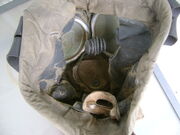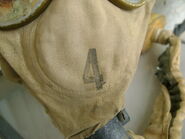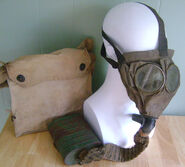The Corrected English Model (CEM) respirator was produced in October of 1917 to replace the American Small Box Respirator (ASBR); the US version of the British Small Box Respirator (BSBR.) Over 1,864,000 CEM's were produced.
One of the biggest improvements that the CEM made over the ASBR was the reduced size of the filter which contained activated coconut charcoal.
The CEM came in five sizes: 1, 2, 3, 4, and 5 (rare size.)
The CEMs canvas is a cloth-like material. Most of the CEMs today are very hard and brittle, while some lucky few actually are still pliable. Most of the hardened CEM's tend to sprinkle black particles from inside of the facepiece when moved, which is the inside of the facepiece falling apart.
The CEM have been noted to feature glass and celluloid eye lenses. Some examples of the CEM today have completely fogged up lenses, making it impossible to see when donning the mask. (Although it is not wise to don the CEM in the first place, considering it's almost 100 years old.)
The inside of the facepiece featured a metal nose clamp and a rubber mouth piece. Both

Inside of the facepiece. Nose clamp and mouthpiece are visible.
of them were to be used in order for the mask to function properly.
The CEM also features an MI style exhale valve; also known as a "flutter" or "flapper" valve. Sadly, the exhale vavle tends to be missing, due to how fragile they become over the years. Early CEM's didnt feature the metal exhale vavle guard. The early guard was thin, and the later guards were a lot thicker, providing more protection and durability.
The CEM features a 5-point non-adujustable head harness, but very uncommon CEM's feature an adjustable 5-point head harness. Due to most CEM's not having an adjustable head harness, size was very important.
The hose on the CEM is made of a thick rubber, and is protected with a cloth-like material (same material as the facepiece.) The hose is attached to the mask and filter by a metal wire. Attached to the hose was a small booklet which contained a log for the user to fill out everytime the mask was used. It also featured some patches incase the canvas were to rip and the user could make a quick-fix.
The CEM had two different types of filters. Early CEM's came with the yellow "H" filter and later models featured the green "J" filters. The filter is much lighter than ASBR filter.
The haversack for the CEM was worn around the user's neck and the filter was placed into the haversack. Some CEM's were stored in their haversacks for very long periods of time, thus making the facepiece fold over and harden.
The CEM is very common on the market, and often times you can buy one in good condition for under 100 USD.
Gallery
References: US Chemical and Biological Defense Respirators: An Illustrated History by Christopher T. Carey.









